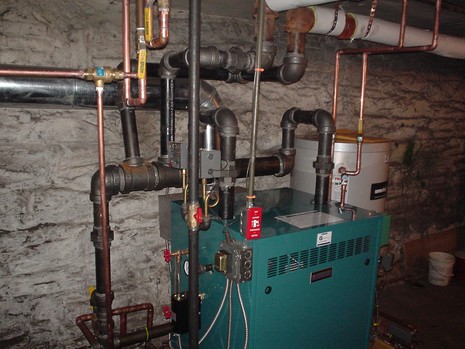What is the Status of Your Basement Heating Pipes? Asbestos? Bare? Insulated?
Posted by BIP on 7th Oct 2015
If your home has a steam or hot water heating system your basement is most likely full of heating pipes near the boiler and in the overhead. We find through interactions with our customers that there are four likely statuses of your basement pipe insulation:
Basement Heating Pipe Status:
1. Have Asbestos Pipe Insulation - Due to the fact that steam or HW heating systems are found mostly in older homes, we can gather that most homes with a boiler system had or currently have asbestos pipe insulation in their basements and/or crawlspaces.
Problems and Concerns:
If you have asbestos pipe insulation, your heating system is most likely efficient because the pipes are insulated. However, with asbestos insulation our concern is not about saving energy but rather the possible health hazards. As you already know asbestos fibers that reach the air can be breathed in and cause health problems. You will want to consider calling an asbestos removal company to remove the all of the insulation properly.
2. Bare Pipes - This status is the very common in homes because the previous owner had all of the visible / reachable asbestos insulation removed in order to sell the home. Today's real estate agents will highly suggest having a professional remove the asbestos insulation to make the home easier to sell in order to eliminate any problems. The seller would have no interest in re-insulating the pipes and most likely will leave the pipes bare with ZERO insulation.
Problems and Concerns:
If you are one of the "lucky" home buyers mentioned above, you will find that when the heat is on your basement becomes a 150F sweat box. In this scenario you will want to insulate the pipes as soon as possible to stop heating the basement and allow your system to kick off once in a while. Proper insulation can save you hundreds of dollars per heating season.
Check out Jeff M's Dollar Savings Example or Dan F's Dollar Savings Example
3. Partial Insulation - Another common status is when some of the pipes have either asbestos or fiberglass pipe insulation but not every pipe is properly insulated. We find this to be common in homes where a new boiler was installed; the old pipe insulation was removed and never re-insulated on the new piping. This also includes homes where the homeowner threw a few lengths of "hardware store" bought cheap pipe insulation sporadically around the basement. This is not enough. If only 1/2" thick insulation was used, simply touch the pipe insulation and feel the heat. The heat you feel is leaving the system and the insulation is not efficient enough.
Problems and Concerns:
Like the scenario above, you will find that your basement is hotter than normal and that your boiler is working overtime. Your best bet is to finish up insulating all of the pipes and completing the insulation system.

4. Properly Insulated - Most of our customers have this status in their basement and you can too. Each supply and return pipe is insulated with a minimum of 1" thick Fiberglass Pipe Insulation and each fitting (elbow / tee / union) is covered by a PVC Fitting Cover. No pipes are left bare and the basement remains cooler than the upstairs which means that the pipes are not losing heat down in the basement.
Problems and Concerns:
When your heating pipes are properly insulated you will notice that your basement is much cooler than the rest of the home which is a good thing. You will notice that your boiler kicks off rather than running constantly (even on the coldest of nights!). Next step for you is to figure out what to buy with the savings on your fuel bill!
Heating season is here already and now is the time to go down in the basement and properly access your current "insulation status". If you have asbestos consider removal. If you have bare or partial insulation you came to the right place, we can help! If you think your pipes are properly insulated double check each pipe and make sure it is insulated including pipe unions! Have a Happy Heating Season!


